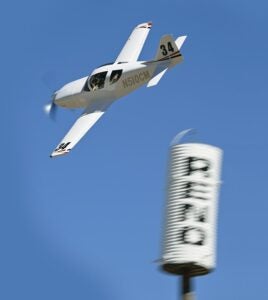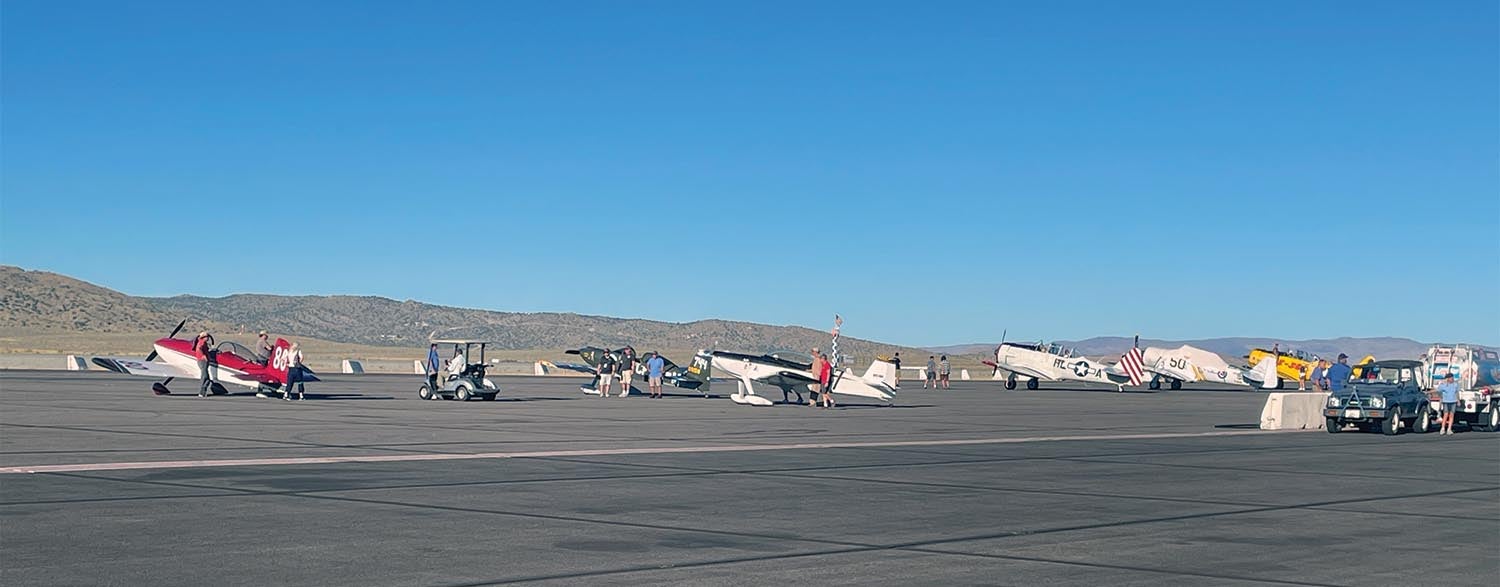I will admit up front that air racing has never been one of my passions. Sure, I was aware of it, mostly in a historical sense, because I have absorbed all things aviation since I was about 3 years old. But aviation is big and air racing is just one tiny niche, so mostly I was aware of the Cleveland races of yesteryear, of Doolittle and the Gee Bees, and of the classic cross-country races for the Bendix Trophies. Oh, I might have had a plastic model of a Schneider Trophy racer—never did figure out why someone thought that dragging big floats around made an airplane faster.

Glasair roaring past at 50 feet doing
400 mph! (Photo: Richard VanderMeulen)
And yes, I was aware that modern air racing took place in a distant village named Reno—but it was just one event on the aviation calendar splattered with huge events. Until, that is, I reached a point in my life where we were looking for a place to retire, and the slopes of the Eastern Sierra around Lake Tahoe looked terribly inviting. It was probably 2008 when we went skiing and looking for an airpark home in the area. We soon realized that the Reno Races were going to be in our backyard and therefore were going to become a significant part of our September life each year. I thought at the time we’d become volunteers on the pylons or in the pits, but it turned out that the aviation media thing came along, and I’ve been attending each year looking for stories and (mostly) enjoying the company of fellow aviators doing what they love—flying low, flying fast and turning left!
While I love pretty much anything that flies, I gravitate to the things I can afford, which are Experimental homebuilt aircraft. I don’t move in the circles of people who own P-51s or jets (or even a lowly T-6) and haven’t been bitten by the biplane bug (probably because I like to go fast as well as fly aerobatics), so my interests at Reno have always settled on the Sport class and Formula 1 planes and teams. A curious thing happened about the same time as we began planning our eventual move to the High Sierra—the “Metal Mafia” began to infiltrate Sport class racing.
The Sport class began in 1998, mostly with things like Lancairs and Glasairs—composite airplanes with sexy lines and good speed potential. But back in the early 2000s, many homebuilders began weekend cross-country racing in the Sport Aviation Racing League. Once racing gets in your blood, it is hard not to look for ways to go faster, and the SARL pilots (many of whom were flying RVs because they were quick and becoming a dominant force in E/A-B) realized that they could, with a little practice, join the Sport class racers at Reno. This caused the Sport class to swell significantly in size, and the aluminum airplanes became a significant force as they created a Medallion heat in addition to the Gold, Silver and Bronze heats that had existed for many years. It’s hard to quantify exactly, but at one time in the early twenty-teens, metal airplanes filled Medallion and Bronze, with some nibbling away at the slow end of the Silver heat.

This “democratization” of Sport Class was noticed—previously, the only way folks at the low and middle end of the economic spectrum could race around the pylons was to build a Cassutt or Shoestring and race in the Formula 1 crowd with their O-200s. But now, anyone who could afford to build and fly an RV could get a chance at September glory in the sunny high-desert skies outside of Reno. I began to attend regularly and followed the class as the RVs got faster, and then one by one we began to see more Lancairs and Glasairs show up—maybe the owners/builders/pilots began seeing the coverage in KITPLANES® and figured heck, I can go faster than an RV, so maybe I should finish this airplane and get to Reno! The net result was that the slower RVs got pushed back out of the back end of the Sport class heats, and we saw fewer of them. But it was fun while it lasted and many generated significant speed with nitrous and turbocharging.
For me, the Reno races became a September tradition—not so much because of the racing but because of the friends I made in the cockpits and the teams. The atmosphere in the pits was always welcoming, and I could pretty much walk in on any racer and ask how it was going and what they were doing for more speed. Both the Sport and F1 teams were very open and welcoming, although I am sure a few secrets were withheld for “competitive purposes.” That was fine—I always respected the fact that we were visitors into their world, and I think they respected that respect.

Now the epoch of racing at Stead is over, driven out by expansion of the city and the demands of the non-aviation world. As the sun sets on the bittersweet final day, with tragedy in the air but hope for a future (elsewhere) in the hearts of those who love racing, we never did find out who was faster at the top of the Sport class heap. And perhaps that is appropriate because it signifies that the racing isn’t over. We still need to see who will take the Gold. Think of it as a “to be continued,” as LaVelle, Findlay and the rest move to a new home, or perhaps several homes, to carry on the competition begun in 1964 at a small dirt and broken-concrete strip on the north side of Reno (the old Reno Sky Ranch). Air racing didn’t begin there (or then)—it began at flying fields across America and Europe as soon as two airplanes came together and the pilots wanted to know who was fastest. Air racing continued to grow and move around, with the “golden age” in the 1930s. But always it was about faster and faster.
We’ll certainly keep track of our racing friends and catch up with them (at least on the ground) at future venues. I’ll miss the cool evenings on the ramp at Stead Field in September but look forward to those who continue to challenge one another around the pylons to see who can get to the checkered flag first. Aviation just wouldn’t be the same without the races…no matter where they are held.













Wendover, Utah/Nevada fits the bill almost perfectly, Absolutely ideal runways, open terrain with no housing etc. incursions for the foreseeable future. Lots of Hotel rooms and Casinos, Historic WW2 airport, Bonneviille Salt flats near by. Only down side SLC is a bit far.